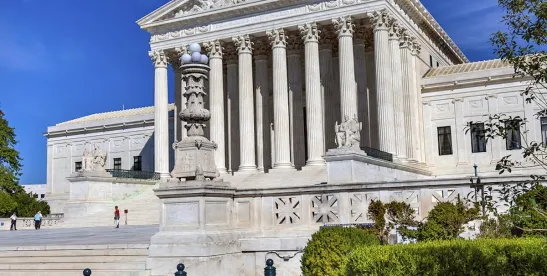The Background
In Jones v. SEC, 298 U.S. 1 (1936), the Supreme Court considered the extent of the regulatory power conferred on the newly created Securities and Exchange Commission (SEC) by the Securities Exchange Act of 1934.
The sponsors of the J. Edward Jones Royalty Trust filed a registration statement with the SEC seeking to issue shares to the public. The SEC, suspecting that the statement contained some false representations, sent a notice to the applicant to appear and show cause why a stop order should not be issued, suspending the effectiveness of the registration statement. Subsequently, the Commission issued a subpoena requesting certain financial records from the applicant. In response, the applicant formally withdrew the application.
The Commission refused to allow the withdrawal, citing a regulation requiring the Commission’s consent to the withdrawal of a registration statement. The trust sponsors sought relief from a federal district court, but that court dismissed the petition for lack of jurisdiction. The Commission then obtained an order from a federal district court requiring that the sponsors turn over the requested financial information. The sponsors appealed, asserting their right to withdraw the application and challenging the statute’s constitutionality.
Jones v. SEC was decided approximately one year after the Court had unanimously invalidated the National Industrial Recovery Act and three months to the day after the Court had invalidated the Agricultural Adjustment Act, two other major pieces of New Deal legislation.
The Court’s Opinion
In an impassioned opinion by Justice George Sutherland in Jones v. SEC, 298 U.S. 1 (1936), the Court ruled that Jones had an absolute right to withdraw its application and that the Commission did not have the power to require it to disclose financial records if it did not intend to sell shares to the public. The Court found it was unnecessary to rule on the constitutionality of the statute, which, of course, we still have today.
Sutherland viewed the SEC’s attempt to investigate the J. Edward Jones Royalty Trust subsequent to the Trust’s withdrawal of its request to offer shares to the public as an outrageous example of regulatory overreach.
Analogizing the Jones application to an ordinary complaint filed in law or equity, Sutherland cited authorities holding that a plaintiff had an unqualified right to withdraw a complaint unless the withdrawal would subject the defendants to some prejudice beyond merely being subjected to another suit in the future.
Sutherland found that there was no evidence of prejudice to anyone. Sutherland explained: “So far as the record shows, there were no investors, existing or potential, to be affected. The conclusion seems inevitable that an abandonment of the application was of no concern to anyone except the registrant.” Id. at 21. He noted that the Commission itself had invited the applicant to show cause why its registration should not be suspended. He commented, “In the face of such an invitation, it is a strange conclusion that the registrant is powerless to elect to save himself the trouble and expense of a contest by withdrawing his application.” Id. at 23.
Sutherland found that the SEC’s action violated the cardinal precept upon which all our constitutional safeguards rest “that this shall be a government of laws.” Id. at 23. He explained that the purpose of these safeguards was to ensure that Americans were not subject to “the mere will of an official or official body.” Id. at 23-24. He added that when these safeguards are not adhered to, “the government ceases to be one of laws and becomes an autocracy.” Id. at 24. He warned of the slippery slope of rights being infringed upon in the “mildest and least repulsive form,” leading ultimately to the complete erosion of those rights. He explained that “arbitrary power and the rule of the Constitution cannot both exist.” Id. at 24.
Sutherland only picked up steam from there. He cited the 18th Century English case, Entick v. Carrington, concerning the rights against unreasonable searches and seizures, self-incrimination, and ex post facto criminal liability against which the drafters of the Constitution were so careful to protect Americans. He noted that these dangers “were among those intolerable abuses of the Star Chamber which brought that institution to an end at the hands of the Long Parliament in 1640.”Id. at 27.
In a line that encapsulated his view of the larger issues involved, Sutherland stated, “The fear that some malefactor may go unwhipped of justice weighs as nothing against this just and strong condemnation of a practice so odious” Id. at 27. He added that the federal courts remained open to the government for the pursuit of criminal activity.
The Dissent
Justice Benjamin Cardozo wrote a dissent in which he was joined by Justices Brandeis and Stone.
Cardozo asserted that the statute gave the Commission broader investigative powers than the majority found. Speaking of the applicant’s withdrawal of its application in the face of the Commission’s determination to investigate its financial records, Cardozo said, “Recklessness and deceit do not automatically excuse themselves by notice of repentance.” Id. at 30. He added, “There will be only partial attainment of the ends of public justice unless retribution for the past is added to prevention for the future.” Id. at 30.
Cardozo characterized the rule requiring the Commission’s consent to the withdrawal of an application as one “wisely conceived and lawfully adopted to foil the plans of knaves intent upon obscuring or suppressing knowledge of their knavery.” Id. at 33.
Cardozo explained: “The opinion of the court reminds us of the dangers that wait upon the abuse of power by officialdom unchained. The warning is so fraught with the truth that it can never be untimely.” Id. at 32. However, he added that “timely too is the reminder as a host of impoverished investors will be ready to attest that there are dangers in untruths and half-truths when certificates masquerading as securities pass current in the market.” Id. at 32.
Cardozo ends by characterizing Sutherland’s analogy to the Star Chamber as a gross exaggeration, noting that the SEC is “a Commission which is without coercive powers, which cannot arrest or amerce or imprison though a crime has been uncovered, or even punish for contempt, but can only inquire and report.” He found it unjustified that such a commission “is likened with denunciatory fervor to the Star Chamber of the Stuarts.” Id. at 33.
The Dissent In Context
Despite the hyperbole concerning the SEC’s resemblance to the Star Chamber, Sutherland’s view of the issue has considerable justification. The SEC was created to regulate the sale of securities to the public. Because it never offered any for sale, it follows that the J. Edward Jones Royalty Trust was not obligated to open its financial records to the SEC’s investigators.
Cardozo’s dissent is perhaps best understood in light of the 1929 Stock Market Crash and its disastrous consequences for investors, large and small.
The shares J. Edward Jones proposed to offer to the public were in an investment trust. In his popular history, The Great Crash: 1929, written in the 1950s, economist John Kenneth Galbraith describes investment trusts as they worked in the late 1920s. Galbraith asks his readers to consider the example of an investment trust that raised $150 million, $50 million each from the sale of common shares, bonds, and preferred stock.
“If this $150 million were invested, and if the securities so purchased showed a normal appreciation, the portfolio value would have increased …[within six months] by about 50%. The assets would be worth $225 million. The bonds and preferred stock would still be worth only $100 million; their earnings would not have increased, and they could claim no greater share of the assets in the hypothetical event of a liquidation of the company. The remaining $125 million therefore would underlie the value of the common stock of the trust. The latter in other words would have increased in asset value from $50 million to $125 million, or by 150%, as the result of an increase of only 50% in the value of the assets in the trust as a whole.
This was the magic of leverage, but this was not all of it. Were the common stock of the trust which had so miraculously increased in value, held by still another trust with similar leverage, the common stock of that trust would get an increase of between 700 and 800% from the original 50% advance. And so forth. In 1929 the discovery of the wonders of the geometric series struck Wall Street with a force comparable to the invention of the wheel.” Id. at pp. 57-58.
With his characteristic sardonic understatement, Galbraith notes, “Leverage, it was later to develop, works both ways.” Id. at 59.
Galbraith ends the chapter with an excerpt of testimony given at a 1932 U.S. Senate hearing on stock exchange practices in which Senator James Couzens of Michigan questioned Walter Sachs of Goldman Sachs, one of the largest sponsors of investment trusts. Senator Couzens asked Mr. Sachs at what price his company had sold shares in a particular investment trust to the public. Mr. Sachs answered, “at 104.” Senator Couzens asked, “What is the price of the stock now?” Sachs answered, “approximately 1 ¾ .” Id. at 64-65.
The geometric rise in share prices had its counterpart in the near inevitability of geometric decline. At the time Cardozo wrote his dissent, many Americans were still suffering the consequences of the catastrophic losses they suffered through the purchase of “certificates masquerading as securities.”




 />i
/>i

